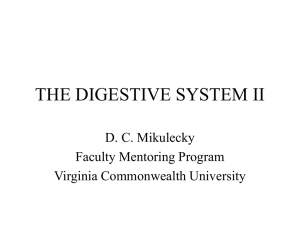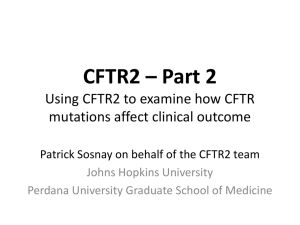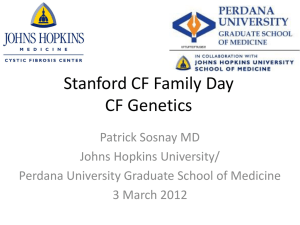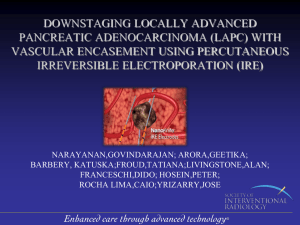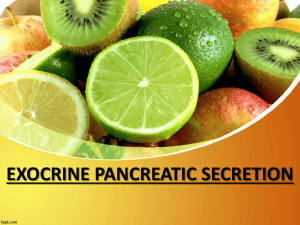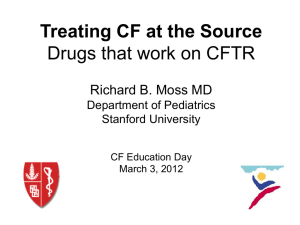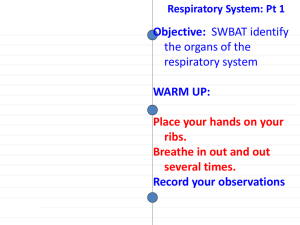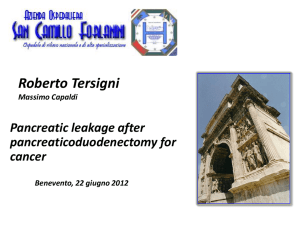PowerPoint Slides
advertisement
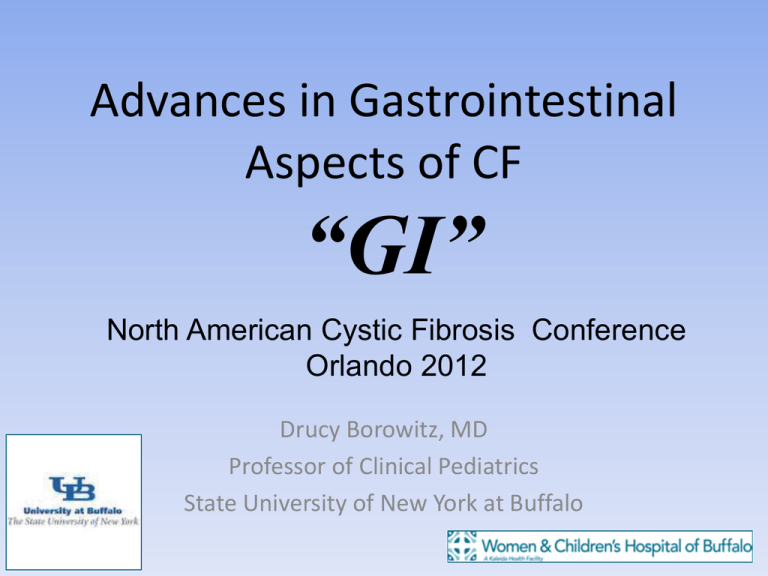
Advances in Gastrointestinal Aspects of CF “GI” North American Cystic Fibrosis Conference Orlando 2012 Drucy Borowitz, MD Professor of Clinical Pediatrics State University of New York at Buffalo Gain Insights into Gastrointestinal Aspects of CF • Recognize similarities between the respiratory and GI tracts in CF • Understand CF GI pathophysiology • Compare findings in CF animal models and CF infants • Learn about new technologies to explore CFTR dysfunction Disclaimer Statement • My employers, the State University of New York at Buffalo and University Pediatric Associates have received payment for my research and consulting activities; I have not received any personal payments Gestational Information: The Respiratory and GI Tracts have the same Embryologic Origins Clearance of Obstruction and Infection LUNGS GI TRACT • ASL hydration and mucociliary clearance • Microvillus and luminal hydration • Cough • Peristalsis • Antimicrobials from submucosal glands • Antimicrobials from submucosal glands Normal GI Tract Physiology CF-Related Liver Disease • “CFLD” is a spectrum : – Neonatal cholestasis, microgallbladder, cholelithiasis, biliary tract ductal stones, common bile duct stenosis, sclerosing cholangitis, hepatic steatosis, nodular regenerative hyperplasia – focal biliary cirrhosis and portal hypertension are the most serious complications • ~ 5 to 10% of CF patients will develop cirrhosis / PHT in the first 10 years of life – no correlation between ↑ transaminases and cirrhosis / PHT • PUSH is a CFF-NIDDK collaboration to explore early biomarkers of cirrhosis Liver and Pancreatic Ducts Secrete Bicarbonate (HCO3- ) via CFTR to Neutralize Gastric Acid Liver (HCO3) GI epithelium (especially Brunner’s Glands) also secretes HCO3- via CFTR Crypt-villus location of duodenal HCO3- secretion under cAMP-stimulated conditions: Abstract 126 Symposium 15 Walker et al, Gastroenterol 2009 Why is HCO3 Secretion Important? • It neutralizes gastric acid – Needed for pH optima of pancreatic enzymes and micelles • It allows mucins to unfold / hydrate Abstracts # 99 & 501 • It promotes bacterial killing Abstracts # 13 & 131 • HCO3 secretion ≡ Fluid secretion Bicarbonate Drives Fluid Secretion The normal human pancreas secretes 1-2 L / day Novak et al, J Biol Chem 2011 Pancreatic Enzyme and Bicarbonate Secretion have Different Stimuli Secretin stimulates duct to secrete bicarbonate Cholecystokinin (CCK) stimulates acini to release enzymes How can you measure GI HCO3? “pH pill” • Measures pH, pressure and temperature • Single use • Radiofrequency detector worn outside body Gastric Acid Neutralization is delayed in Subjects with CF N=20 N=20 Gelfond et al, Dig Dis Sci. 2012 Could Activation of CFTR with Ivacaftor ↑ GI Bicarbonate? • Pancreatic tissue becomes atretic but the duct is still present – MRI – Pathologic studies – PI patients have ↓ but not absent HCO3 secretion Kopelman et al Gastro 1988 • Submucosal glands are obstructed, but are still present Gastric Acid Neutralization is normalized in Subjects with CF taking Ivacaftor Small bowel pH changes (1min means) 8 Pre VX-770 Post VX-770 p< 0.05 7 pH 6 5 4 3 0 8 0 5 24 10 15 20 25 30 35 40 45 50 55 60 65 70 75 80 85 90 95 100 105 110 115 120 Minutes from gastric emtpying N=7 The Earliest Clinical Consequences of CF are Gastrointestinal Pancreatic Insufficiency Meconium ileus (MI) • What is the ontogeny of these conditions? • How can we study them? • Animal models • Human infants Google Infants: Human and Otherwise What have we learned from CF mouse models? What have we learned from CF ferrets and pigs? What have we learned from infants with CF ? Lessons from CF Mice Restoration of CFTR in intestinal epithelium eliminates obstruction Hodges et al, Am J Physiol GLP 2011 Restoration of 10-15% CFTR will avoid intestinal obstruction Bowel obstructions occur despite normal pancreatic function Slide courtesy of P. Durie Lessons from CF Ferrets & Pigs • CF Ferrets • 50% die from MI with perforation in ileum or colon • Have mild pancreatic histopathology at birth • CF Pigs • 100% penetrance for MI & PI • Pancreatic disease begins in utero & progresses over time – proinflammatory, complement cascade, proapoptotic, and profibrotic pathways are activated Abu-El-Aija et al, Am J Pathol 2012 Abstract # 180 MI is not caused by pancreatic dysfunction, but is strongly associated with it Pancreatic Dysfunction in Infants with CF • Management of complications of steatorrhea Pancreatic insufficiency can be the can be done by “conservative measures, first clinical manifestation CF including strapping of the buttocks,of defecating in a reclining position, and measures designed – Occurs in a majority of infants to reduce the frequency and bulk of stool”… (such as ) ...witholding butter, ice cream, – Occurs prenatally peanut butter, potato chips, french fried – Treatment with pancreatic potatoes, and mayonnaise….” enzyme replacement therapy (PERT) is life-sustaining Schwachman, Pediatr 1960 Advances in Pancreatic Enzyme Replacement Therapy (PERT) • New Drug Application process improved safety • no longer overfilled • improved stability • free of enveloped viruses Abstract # 447 • 5 delayed release PERTs approved by US - FDA • • • • • Creon (Abbott) Zenpep (Aptalis) Pancreaze (Janssen / J&J) Pertzye (Digestive Care) Ultresa (Aptalis) Normal vs. Fibrosing Colonopathy Smyth et al, Lancet 1994 Schwarzenberg et al J Pediatr 1995 Addressing Issues with PERT Dosing 20 18 # of cases 18 16 14 14 12 10 11 10 9 8 8 4 0 7 5 6 2 13 11 12 4 1 8 6 3 2 2 0 6 Phase IV surveillance study for fibrosing colonopathy is underway Years Baby Observational Nutrition Study (BONUS) sub-study to help answer questions about dosing in infants Growth Investigations • BONUS will also help us understand factors that influence growth in the first year of life • FIRST (Feeding Infants Right -- from the Start) • Explores breastfeeding, respiratory infections and growth • Docosahexaenoic acid study • Explored the effects of DHA on pancreatic function as measured by monthly fecal elastase (FE) » FE is unaffected by oral PERT » FE > 200 μg/g and consistent with PS Schematic Pattern of Evolution of Pancreatic Function in Infants in the 1st Year of Life O’Sullivan et al, J Pediatr (in press) Why Do Fecal Elastase Levels Change Early in Life? • High levels low because pancreatic dysfunction evolves over the 1st year • An opportunity to modify disease evolution • Low levels high o • Initial levels may be 2 PI – “false positive” • Other factors • Re-measure FE at 1 year of age Garner Intelligence Poohed Microbiomics: Interactive Symbiosis • Human intestine is colonized by an estimated 100 trillion bacteria – – – – Bronchi Promote optimal digestion Maintain epithelial homeostasis Modulate fat metabolism Promote angiogenesis and enteric nerve function – Support resistance to infection • Dysbiosis in patients or animal models is associated with – – – – – inflammatory bowel disease obesity cancer diabetes allergy Microbiomic Techniques • Culture independent using 16S ribosomal RNA • Data are analyzed in terms of: • • • • • Relative abundance Diversity / Richness Presence or absence of taxa Evenness (distribution) Total bacterial load QPCR Symposium # 10 Reference genomes from the human microbiome Bacterial Communities in Mammalian Intestine Adapted from Hill et al, Mucosal Immunol 2009 Abstract # 326 Correlation between Fecal and Respiratory Microbiomes in CF • 7 infants with CF diagnosed by NBS, followed for 9-21 months • 14 of 16 genera increasing in the gut were also increasing in the respiratory tract • For 7 of these 16 genera, gut colonization presages appearance in the respiratory tract Madan et al, mBio 2012 Heat Map and Simpson’s Diversity Index of Respiratory and Fecal Microbiomes Abstract # 279 a= microbes with increased abundance in the intestines early in life b= later in life GI and Respiratory Tract Commonalities • Selective epithelial barrier + mucus-gel layer • Protects against bacteria, pathogens and foreign antigens • Mucosa-associated lymphoid tissue (MALT) • Regulates antigen sampling, lymphocyte trafficking and mucosal host defense • “ It is most likely that it is the similar inflammatory and immune components of these organs that are the cause of the overlap in pathological changes in respiratory and intestinal mucosal diseases”. Keely et al, Mucosal Immunol. 2012 Go Inside • Immune responses to intestinal bacteria inflammation: • • • • Bacterial signals Toll-like receptors NOD-like receptors G protein-coupled receptors • Measureable clinically with Abstract # 522 lab tests and video endoscopy Hill & Artis, Ann Rev Immunol 2010 Capsule Video Endoscopy shows Inflammation in CF Intestine Healthy jejunum Videos courtesy of M. Wilschanski, Jerusalem Patient with CF Abstract # 510 Grab Intestine • New preclinical model systems and clinical trial biomarkers • Rectal short circuit current measurements (ICM) • Organoids Rectal tissue as a biomarker and preclinical model system for CFTR Initially based on European experience, now TDN-sponsored SOP Can do direct or suction biopsy Advantages: Abstract # 210 Accessible High expression Multiple ex vivo assessments Can apply reagents not suitable in vivo Can apply agents to apical or basal side ICM , biochemistry, metabolomics, etc. Colonocyte Ion Transport Cl- ClCFTR Na+ Amil ENaC K+ CaCC KvLQT SK IK BK cAMP Ca++ cAMP Na/K/2Cl Na+HCO3- Ca++ 2K+ cAMP Ca++ NBC1 ~ NKCC1 Bum KvLQT IK 3Na+ K + Adapted from H. DeJonge K + • Differences from respiratory epithelial ion transport: – Presence of K+ secretory pathway – Colon is an absorptive cell (i.e. has more Cl- secretion ) Standard Rectal ICM Recordings Abstracts # 175 & 256 1A. Non-CF 1B. CF CFTR response 300 400 350 Isc (uA/cm2) 250 CCh 300 Bum 250 200 Indo CFTR response 200 150 Fsk/IBMX AmilFsk/IBMX CCh Bum 50 100 0 50 -50 0 -100 20 Indo Amil 100 Amil 150 Indo 40 60 Time (min) 80 20 40 60 80 Time (min) ↓ response to F/IBMX, mixed response to CCh b/o K+ transport in absence of CFTR Intestinal current measurements: genotype/phenotype relationships -180 More CFTR function -150 CFTR current -120 -90 -60 -30 30 Controls Carriers CF-PS CF-PI Solid line, median; dashed line, 25th and 75th percentiles Hirtz, S. et al. Gastroenterol, 2004 Organoids / Enteroids / Colonoids* o • Are 1 cultures that can express crypt and/or luminal domains • Lgr5+ cells at base of crypts generate all cell types in crypt-villus axis • Can study – Crypt secretory physiology in an integrated cell culture environment – Luminal absorptive physiology • Have been created from • Mouse and human intestine • Mouse and human embryonic stem cells * See Stelzner et al Am J Physiol GI Liver 2012 for NIH nomenclature Crypt Culture in 3D Gels – “Enteroids” Sato et al, Nature 2009 Enteroids isolate intestinal epithelium from microbial population and systemic factors • Changes caused by microbial environment: • Goblet cell hyperplasia • Changes intrinsic to epithelium with CFTR dysfunction: • Hyperproliferation: – May be caused by alkaline pH – May give clues to ↑ incidence of GI cancers in CF • Goblet cell degranulation defect: – Mucus that is released stays attached to goblet cells Liu J et al, Am J Physiol Cell 2012 With additional work from L. Clarke lab, Missouri Goblet Cell Degranulation after Carbachol Wild Type CF Knock-out Mouse Abstract # 122 lumen lumen Normal Degranulation Videos courtesy of L. Clarke lab -Missouri Granules go into the lumen without undergoing dissolution “The submucosal gland contains the elixir of airway health “ – Dr. Jeff Wine Abstracts # 86, 87, 89 Forskolin induces rapid swelling of organoids Healthy human organoids F508del / F508del organoids treated with VX-809 + VX-770 |--40μm --| F508del / F508del organoids |--30μm --| Videos courtesy of J. Beekman lab, Utrecht NL Forskolin-induced swelling in intestinal human organoids can be quanitated Abstract # 191 N=8 N=2 N=11 J. Beekman lab, Utrecht NL Generalize Insights • There are similarities between the respiratory and GI tracts • CFTR dysfunction causes pathology in both via obstruction-infection-inflammation • Animal models and techniques used to explore one system lend insight to the other • Treatments that focus on CFTR modulation are likely to improve GI as well as respiratory tract function Gee, I think this is The End(s)!

